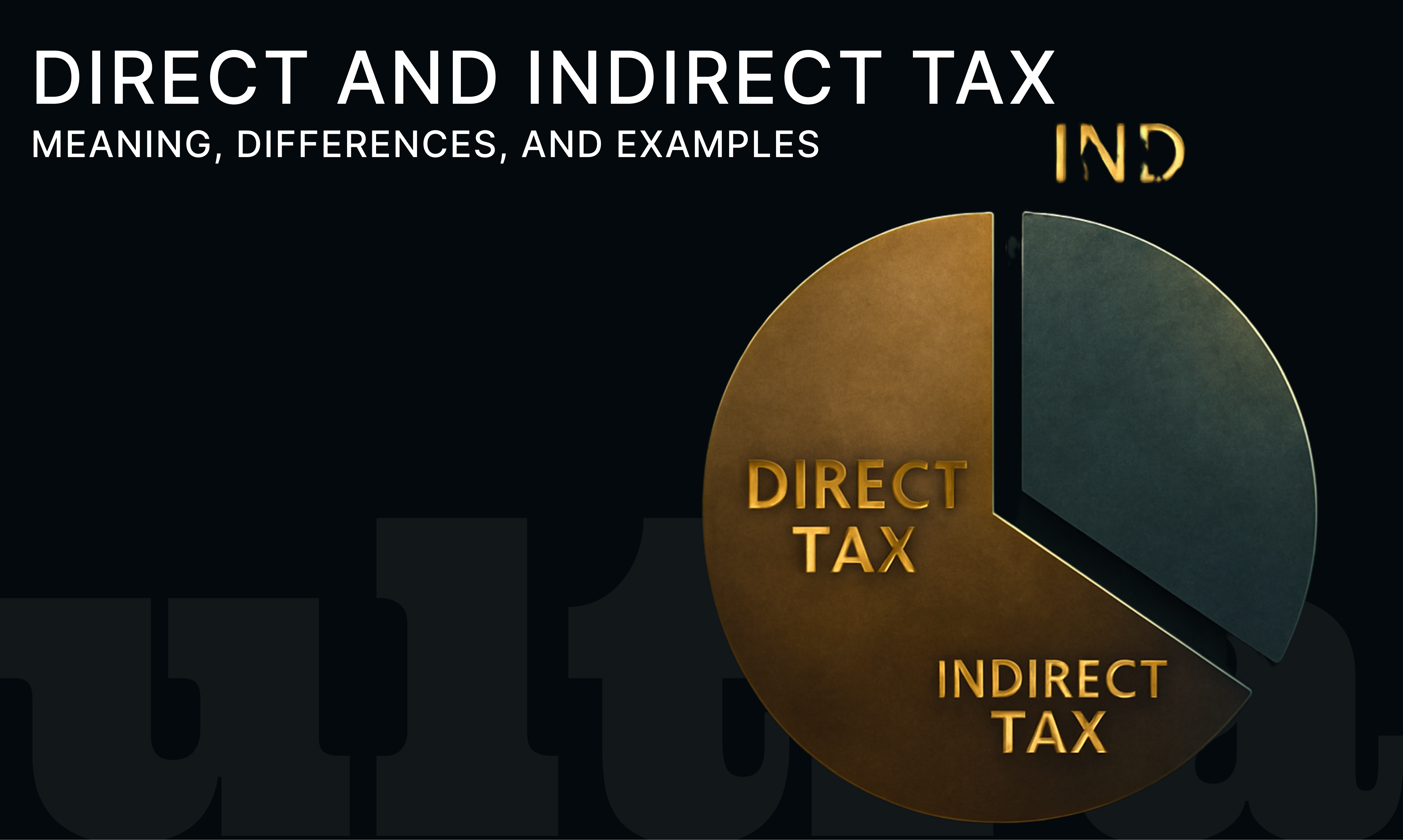Direct and Indirect Tax: Meaning, Differences, and Examples
08 July 2025 · Sachin
What is Direct and Indirect Tax? Meaning, Differences, and Types Explained.

What is Direct Tax?
At Ultra, we believe in empowering investors and taxpayers with clear financial knowledge. Understanding direct and indirect tax is crucial for every working individual, business owner, and investor in India.
In this detailed guide, we explain what is direct tax and indirect tax, their key features, the difference between direct and indirect tax with examples, and why they matter for India’s economic structure.
Direct tax is a type of tax that is directly paid by an individual or organisation to the government. The burden of a direct tax cannot be shifted to another person.
Key features of direct tax:
Collected directly by tax authorities from taxpayers
Paid by the same person who bears the tax burden
Progressive in nature (higher income = higher tax rate)
Examples of Direct Tax in India:
Income Tax: Tax paid on an individual’s annual income.
Corporate Tax: Tax on net profits of companies.
Capital Gains Tax: Tax on profit from sale of capital assets.
Wealth Tax: (Note: Abolished in India from 2015)
Securities Transaction Tax (STT): Tax on trading of stocks and securities.
What is Indirect Tax?
Indirect tax is a type of tax that is collected by an intermediary (like a seller) from the end consumer. Here, the tax burden is shifted from the person paying it to the end user.
Key features of indirect tax:
Collected by an intermediary who pays it to the government
Burden is transferable to the final consumer
Regressive in nature (same rate for all income groups)
Examples of Indirect Tax in India:
Goods and Services Tax (GST): Tax on supply of goods and services in India.
Customs Duty: Tax on imports and exports.
Excise Duty: Tax on production of goods (now largely replaced by GST).
Value Added Tax (VAT): Still applicable on certain items like petroleum and alcohol.
Difference Between Direct and Indirect Tax
| Aspect | Direct Tax | Indirect Tax |
|---|---|---|
| Definition | Tax paid directly to the government by the taxpayer | Tax collected by intermediaries and paid by consumers |
| Tax Burden | Cannot be shifted | Shifted to the end user |
| Examples | Income Tax, Corporate Tax, Capital Gains Tax | GST, Customs Duty, Excise Duty |
| Collection | Collected by tax authorities | Collected by sellers/intermediaries |
| Nature | Progressive | Regressive |
| Compliance | Requires self-assessment, filing returns | Collected automatically during transactions |
Direct and Indirect Tax in India: An Overview
India’s tax system uses both direct and indirect taxes to generate revenue for infrastructure, welfare, and development activities.
Key facts:
Direct taxes contribute about 50% of total tax revenue.
GST is the largest source of indirect tax revenue.
The government continuously reforms tax laws to improve ease of compliance and widen the tax base.
Importance of Direct and Indirect Tax
Both taxes play an important role:
1. Revenue Generation: Taxes fund public goods, welfare schemes, and infrastructure.
2. Economic Stability: Direct taxes help reduce income inequalities through progressive rates.
3. Control of Inflation: Indirect taxes like GST can be adjusted to control demand for certain goods.
4. Behaviour Influence: Certain taxes discourage harmful products (e.g., high GST on tobacco).
Challenges in Direct and Indirect Tax
Tax Evasion: More common in direct taxes due to under-reporting of income.
Regressiveness: Indirect taxes can impact low-income groups more heavily.
Complex Compliance: Both systems require continuous updates, filings, and audits.
Future of Taxation in India
India aims to simplify tax processes with digital platforms like the GST portal, faceless income tax assessments, and e-filing for quick refunds and transparent compliance.
At Ultra, we always recommend that investors stay informed about tax obligations to plan investments smartly and claim all eligible deductions.
FAQs on Direct and Indirect Tax
1. What is the difference between direct and indirect tax with examples?
Direct tax is paid directly by taxpayers (like income tax), while indirect tax is collected by intermediaries and paid by consumers (like GST).
2. What are some examples of direct and indirect tax in India?
Direct tax examples: Income tax, corporate tax.
Indirect tax examples: GST, customs duty, VAT on petroleum.
3. Why do we pay both direct and indirect taxes?
Both are needed to balance government revenue sources, ensure fair collection, and provide funds for national development.
4. Which is better: direct tax or indirect tax?
Both have their purpose. Direct taxes are progressive and help reduce inequality. Indirect taxes are easier to collect but can be regressive.
5. How can I plan my taxes better?
Stay updated on latest tax slabs, file returns on time, invest in eligible tax-saving instruments, and take help from experts if needed.
Final Thoughts
Understanding direct tax and indirect tax helps you make smarter financial decisions and stay compliant. Whether it’s planning your income tax or understanding how GST impacts daily purchases, being aware is key.
Ready to build your wealth and save on taxes? Explore Ultra’s digital platform for investment ideas that fit your tax planning goals.